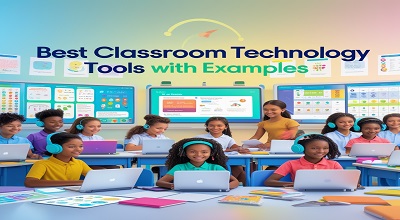Classroom Technology Tools
Classroom Technology Tools: In today’s digital age, integrating technology into the classroom has become essential for enhancing learning experiences, improving engagement, and streamlining teaching processes. From interactive whiteboards to AI-powered learning platforms, educators now have access to a wide range of tools that can transform traditional classrooms into dynamic, tech-driven learning environments.
This comprehensive guide explores the best classroom technology tools available in 2024, complete with examples and practical applications. Whether you’re a teacher, administrator, or edtech enthusiast, this article will help you discover innovative solutions to elevate education.
Classroom Technology Tools
Technology has revolutionized education by making learning more interactive, personalized, and accessible. Modern classroom tools help teachers:
- Enhance engagement through interactive lessons.
- Personalize learning with adaptive technology.
- Improve collaboration among students.
- Streamline administrative tasks with automation.
- Provide real-time feedback to students.
With so many options available, selecting the right tools can be overwhelming. Below, we break down the best classroom technology tools with real-world examples.
Interactive Whiteboards and Smart Displays
Interactive whiteboards (IWBs) and smart displays have replaced traditional chalkboards, offering dynamic ways to present lessons.
Examples:
- SMART Board – Allows touch interaction, digital annotations, and integration with educational software.
- Promethean ActivPanel – Features multi-touch capabilities and cloud-based lesson sharing.
- Google Jamboard – A digital whiteboard that integrates with Google Workspace for real-time collaboration.
Benefits:
✔ Enhances visual learning
✔ Supports interactive lessons
✔ Integrates with other edtech tools
Learning Management Systems (LMS)
LMS platforms help teachers organize course materials, track student progress, and facilitate online learning.
Examples:
- Google Classroom – Free and user-friendly, integrates with Google Drive and Meet.
- Canvas – Used by schools and universities for assignments, quizzes, and discussions.
- Moodle – Open-source LMS with customizable plugins.
Benefits:
✔ Centralizes learning resources
✔ Simplifies grading and feedback
✔ Supports blended and remote learning
Student Response Systems (Clickers & Polling Tools)
These tools allow teachers to conduct live polls, quizzes, and instant feedback sessions.
Examples:
- Kahoot! – Game-based quizzes that make learning fun.
- Mentimeter – Real-time polling and interactive presentations.
- Socrative – Instant assessments with detailed reports.
Benefits:
✔ Increases student participation
✔ Provides instant feedback
✔ Helps gauge understanding
Collaboration and Communication Platforms
Effective communication between teachers, students, and parents is crucial.
Examples:
- Microsoft Teams – Combines chat, video calls, and file sharing for classrooms.
- Flip (formerly Flipgrid) – Video discussion platform for student engagement.
- Slack – Organizes class discussions into channels.
Benefits:
✔ Encourages teamwork
✔ Facilitates remote learning
✔ Keeps stakeholders connected
Gamification and Educational Games
Gamification makes learning engaging through game-like elements.
Examples:
- Classcraft – Turns classroom behavior into a role-playing game.
- Prodigy Math – Math learning through an adventure game.
- Duolingo – Language learning with gamified lessons.
Benefits:
✔ Boosts motivation
✔ Reinforces learning through play
✔ Tracks progress with rewards
Augmented Reality (AR) and Virtual Reality (VR) Tools
AR and VR provide immersive learning experiences.
Examples:
- Google Expeditions – Virtual field trips to historical and scientific sites.
- Merge Cube – AR tool for hands-on science and math learning.
- zSpace – Combines AR and VR for STEM education.
Benefits:
✔ Enhances experiential learning
✔ Makes abstract concepts tangible
✔ Increases student curiosity
Artificial Intelligence (AI) in Education
AI-powered tools personalize learning and automate tasks.
Examples:
- ChatGPT for Education – Assists with tutoring and content creation.
- Century Tech – Adaptive learning platform with AI-driven insights.
- Gradescope – AI-assisted grading for assignments.
Benefits:
✔ Personalizes learning paths
✔ Automates administrative tasks
✔ Provides data-driven insights
Coding and Robotics Tools for STEM Education
Teaching coding and robotics prepares students for future careers.
Examples:
- LEGO Education SPIKE Prime – Combines coding with hands-on robotics.
- Scratch – Block-based coding for beginners.
- Ozobot – Teaches programming through small robots.
Benefits:
✔ Develops computational thinking
✔ Encourages problem-solving
✔ Makes STEM fun
Digital Assessment and Feedback Tools
Digital tools streamline grading and feedback.
Examples:
- Turnitin – Checks plagiarism and provides feedback.
- Quizizz – Self-paced quizzes with instant results.
- Edpuzzle – Interactive video assessments.
Benefits:
✔ Saves grading time
✔ Provides actionable insights
✔ Enhances student reflection
Accessibility and Assistive Technology
Inclusive tools help students with disabilities.
Examples:
- Read&Write – Text-to-speech and speech-to-text tool.
- Kurzweil 3000 – Supports dyslexic students with reading and writing.
- Microsoft Immersive Reader – Enhances readability for all learners.
Benefits:
✔ Supports diverse learners
✔ Promotes inclusivity
✔ Enhances accessibility
Future Trends in Classroom Technology
Emerging trends include:
- AI-driven personalized learning
- Blockchain for secure credentials
- Metaverse classrooms
- Wearable tech for engagement tracking
FAQs
1. What is the most popular classroom technology tool in 2024?
Google Classroom remains one of the most widely used LMS due to its simplicity and integration with Google tools.
2. How can AR and VR improve learning?
They provide immersive experiences, such as virtual labs and historical simulations, making learning more engaging.
3. Are AI tools replacing teachers?
No, AI assists teachers by automating tasks and personalizing learning, but human educators remain essential.
4. What is the best free classroom technology tool?
Kahoot! and Google Classroom are excellent free options for quizzes and course management.
5. How can technology help students with disabilities?
Assistive tech like text-to-speech and speech recognition supports diverse learning needs.
Conclusion
The best classroom technology tools enhance engagement, personalize learning, and streamline teaching. By integrating tools like interactive whiteboards, LMS platforms, AI tutors, and AR/VR, educators can create a futuristic and effective learning environment.
Free Download: BraBet APK
